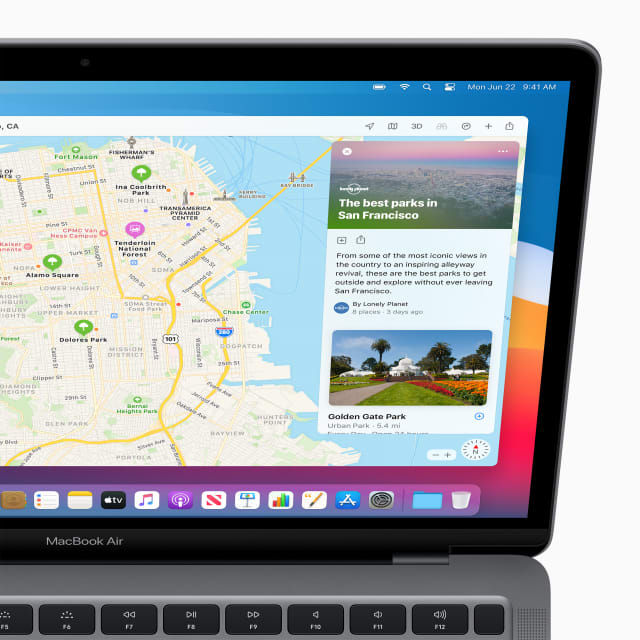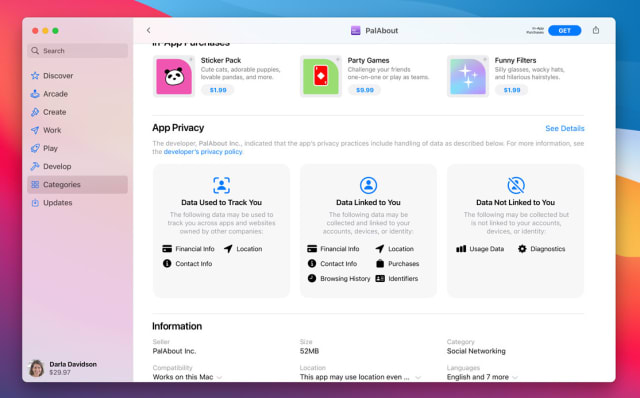Messages and Maps
If you use both an iPhone and a Mac, Messages is probably one of the most important apps you have on both devices. Fortunately, with Big Sur, the Messages experience is nearly identical across platforms. iOS 14 brought a host of new features like in-line replies, the ability to pin conversations, @ mentions and custom images for group chat, improved search capabilities — and they’re all here in Big Sur. Apple also brought a few features that have been in Messages for iOS for years over to the Mac, including built-in GIF search, Memoji stickers and “message effects” (like sending a message with a cloud of confetti or fireworks). So if one friend sends a message from their phone with the laser effect, you won’t see the boring text description “sent with lasers” on your Mac any more. It’s the little things.
The Maps app has also received some major updates, again bringing it inline with what you’ll find on iOS. Google Maps devotees won’t care about these changes, but Apple Maps on the iPhone is actually very good these days (at least in the US). But, like Messages, Maps on the Mac was missing a lot of features that Apple had added to its iOS app over the years. Now, they’re in perfect symmetry. The biggest benefit is that any “guide” (basically a list of locations you save) you create on your phone will also be available on the Mac, and vice versa. Previously, Maps only let you add places to a single “favorites” list, but having multiple lists is far more natural. That way, you can save spots you want to visit on a vacation (when we’re allowed to travel again, sigh) separately from your favorite local spots, for example.
All those lists are saved in a new sidebar that also includes favorite spots like your home and work addresses as well as recent searches. Clicking the search field at the top of the sidebar also exposes a signature new Maps feature: Guides. These are third-party curated lists of local spots like restaurants to try and best photo-taking spots; you can save ones that you want to come back to. The guides range from trusted sources like Lonely Planet and The Washington Post, to smaller, more specific options like Fotospot and AllTrails. There aren’t a ton of guides yet, but you should be able to find some for most big cities. There’s guides from about 20 publishers, and hopefully it’ll keep growing over time.

Apple
Finally, Apple’s “Look Around” features, basically an answer to Google Street View, is on the Mac for the first time. It’s only available in “select cities” right now, but given the pace at which Apple has been improving on Maps lately, this will hopefully show up more broadly soon. As is often the case with Apple Maps, the company lags behind Google in a variety of areas, so Google Maps devotees likely won’t switch. But I prefer using Apple Maps for turn-by-turn navigation these days, so I’ve been using the app more and more — having the same experience available on my Mac is important if Apple is going to convert more users to its platform.
Odds and ends
Those are the biggest updates, but Apple made nips and tucks across many other apps. One of the most significant is sadly one that I haven’t gotten to try yet: privacy labels that are being added to every app in the App Store. They’re not live yet, but when they are, you’ll be able to see what tracking data an app can collect, what personal information is linked to a user, and what data is collected but not linked to your identity. Unlike Safari’s Privacy Report, these cards in the App Store are the kind of thing you can check out before installing software so you have a better idea of what a developer might do with your personal information. Given how hard that is to keep track of, this is definitely a smart move. (These cards are coming to iOS soon, as well.)

Apple
Other changes include new video- and photo-editing tools in the Photos app, a redesigned “Listen Now” experience in Apple Music, the ability to assign reminders to other family members, improved search in Notes, and a bunch of other relatively minor updates. Most of these are features that Apple added to iOS 14, so it’s not surprising to see them show up on the Mac. I do appreciate the fact that, over the last few years of software updates, Apple has put more of a focus on keeping the feature sets for its core apps in sync across platforms.
Another change you may have noticed on the iPhone that’s now on the Mac is optimized battery charging. Apple says that it learns about how you use your computer and optimizes charging to avoid wear and tear on your battery. In practice this means that the OS holds the battery charge at 80 percent when the computer is plugged in for “extended periods of time” (like overnight). It then makes sure the battery is full at times when you typically unplug. I can’t say if this has made any difference to my battery yet, but I will say that my charging patterns on a Mac are less consistent than with my phone, which hits the charger every night. With my laptop, sometimes I’m plugged in all day and other days I wander around the house with only short charging breaks. But I haven’t run into any problems with my Mac not being fully charged when I need it, so I’m leaving the setting turned on for now.



